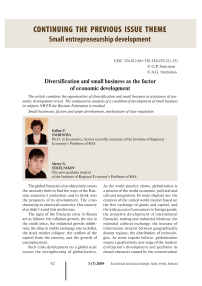Reproductive health as a factor in quality of population reproduction
Автор: Shabunova Alexandra Anatolevna, Kalachikova Olga Nikolaevna
Журнал: Economic and Social Changes: Facts, Trends, Forecast @volnc-esc-en
Рубрика: Social development
Статья в выпуске: 3 (7) т.2, 2009 года.
Бесплатный доступ
The paper substantiates the significance of health for population reproduction, examines reproductive health trends in the Vologda region in comparison with Russia in whole. It reveals main problems and causes of worsening reproductive health and therefore reproduction of population.
Birth rate, reproductive health, quality of reproduction of the population
Короткий адрес: https://sciup.org/147223149
IDR: 147223149 | УДК: 314.33(470.12)
Текст научной статьи Reproductive health as a factor in quality of population reproduction
UDC 314.33(470.12)
Reproductive health as a factor in quality of population reproduction
The paper substantiates the significance of health for population reproduction, examines reproductive health trends in the Vologda region in comparison with Russia in whole. It reveals main problems and causes of worsening reproductive health and therefore reproduction of population.
Birth rate, reproductive health, quality of reproduction of the population.
Alexandra A.
SHABUNOVA
Ph.D. in Economics, Senior Lecturer
The Department Head of the Institute of Socio-Economic Territories
Development of RAS
Olga N.
KALACHIKOVA
The post-graduate student of the Institute of Socio-Economic Territories
Development of RAS
Reproduction of Russia’s population in the conditions of its number’s reduction represents the extremely actual problem exceeding the bounds of the demographic problems’ framework; the country’s economic competitiveness, its place in the world arena, and the state unity’s preservation depends on this problem’s decision. Depopulation can be overcome in two basic ways.
The first and the most significant of them for population’s preservation is the untimely death rate’s decrease. As a whole for the period from 2003 to 2008 the death rate in the Russian Federation has decreased from 16.4 to 14.6 for 1 thousand people. However, in 2007 the same parameter in the countries of the EU made 9.7 for 1 thousand people [2] that is evidence of the necessity of the further improvement of the situation in Russia. Both in the country in general, and in the regions in particular it consists in the infant mortality rate’s decrease; in the reduction of the controlled reasons’ death; in overcoming the untimely death rate among people elder than the able-bodied ones on the basis of the older people’s life quality improvement; in strengthening public health due to the increase of public health system’s efficiency and to the health-protecting behavior of the population [5, 6].
The second way involves the change of the situation in the sphere of birth rate. Here positive changes have taken place for the last decade. The general birth-rate in Russia, having reached the least value in 1999 (8.3%), in 2004
increased to 10.4%, and in 2008 it increased to 12.1%. To compare we can mark that in 2007 in the countries of the European Union the general birth-rate made 10.6% on the average, with the maximal value (13%) in France. And still the substantial increase of birth rate still cannot be observed. But the other fact attracts attention. According to the medical statistics’ data, almost 40% of children in Russia have problems with health from their birth. In this connection it is necessary to be guided not only by the increase of the birth rate, but by its preservation and at the same time by the improvement of the quality of the population’s reproduction. The latter is impossible without population’s reproductive health preservation and increase.
The reproductive health is the major component of the health of a person, a family and a society as a whole. The World Health Services Organization defines the reproductive health as the human ability to conceive and to give birth to children, the opportunity of sexual relations without any threat of the diseases transmitted in a sexual way, the guarantee of pregnancy and childbirth safety, the children’s survival, the mothers’ well-being and the opportunity of the subsequent pregnancy planning, including their undesirable prevention1. Favorable conditions’ and preconditions’ creation for the achievement of the reproductive health optimum level in a society allows women to pass the stage of pregnancy and childbirth safely and gives married couples the best chance to have the healthy baby. The concept “reproductive health” concerns both women and men [8].
Rather often the indices of the maternal and infantile mortality, the rate of abortions, the morbidity of the diseases transmitted in the sexual way, etc. are used for characterizing reproductive health. However, we also should mention the parental health’s potential, especially the reproductive one as in many respects it determines the opportunity for conception, pregnancy and childbirth course, the future child’s health. In this connection it is worthwhile to add the characteristics of reproductive health mentioned above to the block of parameters, illustrating the level (tabl. 1).
Owing to the incomplete statistical data the reproductive health research is carried out at the regional level.
From the beginning of the XXI century the reproductive potential’s decrease in the future parents’ health has been marked. The sickness rate of the urogenital system’s diseases of the population in Vologda region increased from 30 cases for 1 thousand people in 2000 to 40 cases in 2007 (fig. 1) .
The diseases’ growth on many nosologic forms of both male and female reproductive systems is marked; and that increases the risk of barrenness, different complications during pregnancy and childbirth (tabl. 2) .
The ability to conception and child-bearing has reduced. The rate of the female barrenness has essentially increased (tabl. 3) . The rate of the male barrenness in 2008 4 times exceeded the level of 2000; however it is twice lower than the rate of the female barrenness.
At the same time, according to the data of the World Health Services Organization, in 45% cases of sterile families2 men were the cause of such situation, in 40% cases the reason were women and in 15% cases the reasons of barrenness involve either physiologic incompatibility, immunological barrenness and other reasons. Such inadequacy confirms the existence of the problem of insufficient attention to men’s health from the direction of specialists-andrologists and of referring the part of diagnoses to women; so, the real rate of male barrenness is higher than the statistical rate.
Table 1. Reproductive health’s estimation structure
|
Characteristics |
Parameters |
Units |
|
Future parents’ sexual health |
Urogenital system’s diseases |
1 case to 1,000 people |
|
Endometriosis |
1 case to 100,000 people |
|
|
Cervical erosion and ectropion |
1 case to 100,000 people |
|
|
Disordered menstrual cycle |
1 case to 100,000 people |
|
|
Salpingitis, oophoritis |
1 case to 100,000 people |
|
|
Prostate gland illnesses |
1 case to 100,000 people |
|
|
Human ability for conception and childbirth |
Male sterility |
1 case to 100,000 people |
|
Female sterility |
1 case to 100,000 people |
|
|
Opportunity of sexual relations without any threat of the diseases transmitted in a sexual way |
Gonorrhea |
1 case to 100,000 people |
|
Syphilis |
1 cases to 100,000 people |
|
|
Opportunity of pregnancy planning |
Number of abortions |
To 1,000 women of childbearing age |
|
Contraceptives’ use |
In % from the number of women of the fertilization age |
|
|
Pregnancy and childbirth safety |
Pregnant women’s diseases on nosologic forms |
In % of all parturient women |
|
Complications during pregnancy and childbirth |
1 case to 1,000 women of the fertilization age |
|
|
Preterm delivery |
In % of all parturient women |
|
|
The diseases having complicated childbirth and puerperal period |
1 case to 1,000 childbirths |
|
|
Children’s survival and mothers’ Well-being |
Infant mortality |
A number of dead to 1,000 born alive |
|
Maternal mortality |
A number of dead to 100,000 born alive |
|
|
Congenital and developmental anomalies, deformations and chromosomal infringements |
1 case to 100,000 people |
|
|
A share of children, born patients |
In % of the number of born alive |
|
|
Premature newborns |
In % of the number of born alive |
Figure 1. Sickness rates of the urogenital system’s diseases (for 1 thousand people) [5, 9]
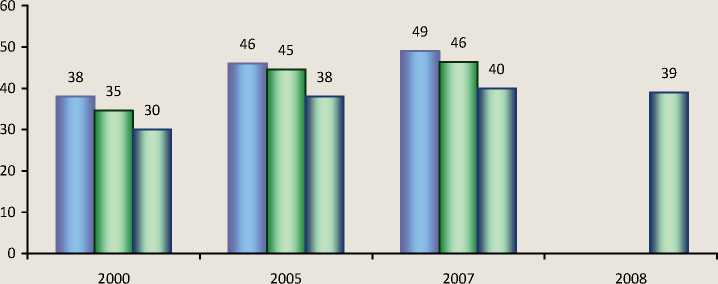
□ The Russian Federation п North-West federal district □ Vologda region
The diseases transmitted in the sexual way are the characteristics of the reproductive health; they also essentially raise the probability of barrenness. Due to the program “Anti HIV-AIDS” realized in the Vologda region, the rate of the general morbidity with the infections transmitted in the sexual way, decreased from 13,211 cases in 2000 to 7,207 in 2007. However gonorrhea as one of the most widespread infections is diagnosed in the region (fig. 2).
Table 2. Sickness rates of the reproductive system’s diseases (for 100 thousand people) [5, 9]
|
Diseases |
2000 |
2008 |
2008 to 2000, % |
|||
|
Vologda region |
Russian Federation |
Vologda region |
Russian Federation |
Vologda region |
Russian Federation |
|
|
Pathologic menopause |
158.2 |
No data |
305 |
No data |
193 |
No data |
|
Endometriosis |
54.3 |
No data |
91.6 |
No data |
169 |
No data |
|
Prostate gland illnesses |
234.8 |
No data |
352.5 |
No data |
150 |
No data |
|
Cervical erosion and ectropion |
545.9 |
812.3 |
687.5 |
807.0 |
126 |
99 |
|
Disordered menstrual cycle |
1 441.1 |
876.9 |
1 549.6 |
1 276.9 |
108 |
146 |
|
Salpingitis, oophoritis |
335.1 |
No data |
272.2 |
No data |
81 |
No data |
Table 3. The rate of the barrenness disease (for 100 thousand people) [5, 9]
|
Barrenness |
2000 |
2007 |
2008 |
2008 to 2000, % |
||||
|
Vologda region |
Russian Federation |
Vologda region |
Russian Federation |
Vologda region |
Russian Federation |
Vologda region |
Russian Federation |
|
|
Male |
0.3 |
No data |
1.2 |
No data |
1.1 |
No data |
367 |
No data |
|
Female |
72.2 |
138.4 |
91.8 |
183.0 |
98.2 |
183.0 |
136 |
132 |
Figure 2. Gonorrhea morbidity (for 100 thousand people) [5, 9]

□ The Russian Federation □ Vologda region
The low level of the sexual and the social-hygienic practices of the population, especially of youth, are the factors of the reproductive health deterioration.
The sociological research3 shows, that the early sexual debut is more characteristic for men: 27% of young men and 15% of girls started their sexual life under 17 years (tabl. 4) . Thus 56% of the first sexual contacts were not protected.
The absence of the social-hygienic practice is also observed among adult population. The analysis of the sociological data has shown that the rate of the population’s knowledge in the reproduction matters from the number of people of the childbearing age is 49% lower than the average regional level (3.9 points on a 5-mark scale).
At the same time 13% of inhabitants of childbearing age have fickle chance sexual contacts, from them 12% do not use contraceptive means at all that increases the probability of the infections transmitted in the sexual way.
Low population’s knowledge in the reproduction matters and the irresponsibility in the sexual behavior increase the risk of the undesirable pregnancy followed by abortion. The analyses of the barrenness’ reasons allowed indirectly prove these conclusions during the realization of program “ECO” which was
Table 4. Distribution of the answers to the question: “ What age have you lived your sexual life from? ”
|
Age |
Men |
Women |
||
|
2007 |
2008 |
2007 |
2008 |
|
|
Under 17 years |
29.1 |
27.2 |
15.1 |
17.7 |
|
After 17 years |
21.8 |
20.3 |
19.8 |
17.1 |
|
Since 18 years and elder |
34.9 |
43.7 |
49.9 |
52.8 |
|
I do not have sexual relations |
13.1 |
7.9 |
14.4 |
11.2 |
Source: the data of the population reproductive potential’s monitoring carried out by the Institute of Socio-Economic Territories Development of RAS, 2007, 2008.
Figure 3. The number of abortions for 1000 women of childbearing age (15 – 49 years) [5, 7]
545361 59
4444 3840
□ The Russian Federation
□ North-West federal district
□ Vologda region
started in the Vologda region in 2005. By the experts’ estimations, 80% of barrenness’ cases were caused by low population’s knowledge in the reproduction matters and the irresponsibility in the sexual behavior.
About 56% of pregnancies in the region are interrupted by surgical procedure. Despite of the reduction of the abortions’ number from 68 for a thousand women of childbearing age in 2000 to 50 women in 2008, the mentioned level is defined as high4 according to the United Nations’ Organization classification (fig. 3) .
One of the important characteristics of the reproductive health is also pregnancy and delivery course. In turn, the reproductive health influences pregnancy course and its result. For the period from 2003 to 2007 the sickness rate among pregnant women increased. Anemia is the most frequent among the diseases; the second place is occupied by the urogenital system’s diseases, and the third place is occupied by edemas, proteinuria and hypertensive disorders (tabl. 5).
The rate of pregnancy and childbirth complications in the region increased from 43 cases for 1,000 women of the fertilization age in 2000 to 59 cases in 2008 (fig. 4) .
The growth of the diseases of the pregnant women and the pregnancy and childbirth complications illustrates the reduction of the women’s health potential as a whole. All this determines the necessity of the complex medical women’s inspection and of updating their health condition at the period anticipating conception. Such necessity is caused by the presence of two tendencies in the reproductive behavior of the population. First, they involve insignificant planning of a family (unexpected pregnancy is a consequence in this case); and secondly, the low level of sexual and social-hy-
Table 5. Pregnant women’s morbidity in 2003 – 2007, % [3, 9]
|
Diseases |
2003 |
2007 |
2007 to 2003, % |
|||
|
Russian Federation |
Vologda region |
Russian Federation |
Vologda region |
Russian Federation |
Vologda region |
|
|
Anemia |
42 |
36 |
39 |
31 |
93 |
86 |
|
Edemas, proteinuria and hypertensive disorders |
22 |
15 |
19 |
11 |
86 |
73 |
|
Urogenital system’s diseases |
20 |
23 |
20 |
20 |
100 |
87 |
|
Blood circulation’s diseases |
14 |
7 |
10 |
7 |
71 |
100 |
|
Venous’ complications |
4 |
2 |
4 |
2 |
100 |
100 |
|
Other illnesses |
– |
11 |
– |
22 |
200 |
|
Figure 4. Pregnancy and childbirth complications, 1 case for 1000 women of the childbearing age (15 – 49 years) [5, 7]
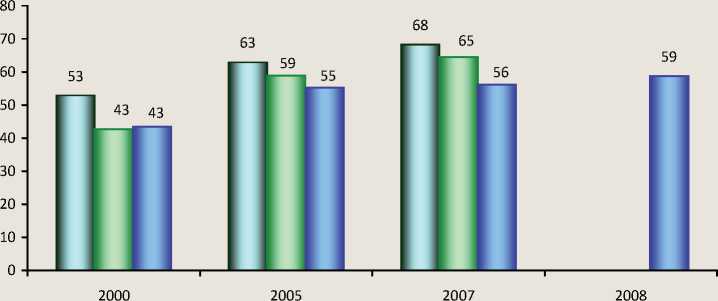
□ The Russian Federation □ North-West federal district □ Vologda region
gienic practice of the population. As a result the probability of the unplanned pregnancy, complicated deliveries, deviations in the fetation, and the birth of an enfeebled child increases. Parents’ health potential, pregnancy and childbirth course in many respects determine the future child’s health; so timely revealing of the existing problems is required.
Preterm delivery, sick children’s birth, maternal and infant mortality, mortinatality are the results of the complicated anamnesis of pregnant women. Approximately 4% of pregnancies in the region come to an end with preterm delivery 5 that is a little bit higher than the all-Russian level (tabl. 6) .
The number of the prematurely born children in Russia makes 5.9% of newborns for the considered period, in the Vologda region it makes 5.5%. The tendency of the prematurity parameter decrease is observed, and in the region the rates of such decrease are higher than the all-Russian rates (tabl. 7) .
At the same time in the region the newborn children’s health improves: in 2000 the share of children, born patients or fallen ill, made 39.9%; in 2007 it made 32.5%; it is less than in Russia in general (fig. 5) . However, even at the positive dynamics, the rate is still rather high. The fact that the positive tendency in this aspect exists, indirectly proves by the decrease of probability for a child to die up to 5-years age (from 19.6 for 1,000 live-born in 2000 to 13 in 2006). In comparison with the countries of the EU in which the similar parameter changed
Table 6. Preterm delivery (in % from the number of parturient women) [5, 9]
|
Territory |
2000 |
2008 |
2008 to 2000, % |
|
Cherepovets |
2.9 |
3.8 |
131 |
|
Vologda |
4.1 |
4.1 |
100 |
|
Areas |
7.0 |
4.2 |
60 |
|
Region |
3.8 |
4.1 |
108 |
|
The Russian Federation |
4 |
3.3 ∗ |
83 |
|
* The data for 2007. |
|||
Table 7. Born premature (in % from the number of the born alive) [5, 9, 10]
The maternal mortality’s rate both in Russia and in the region continues to exceed considerably the level at the countries of the EU (fig. 6) .
Thus, the carried out analysis allows referring to the safest parameters the ones describing the work of the maternity obstetric service which provided the decrease of the maternal and infant mortality rate and the prematurely born children’s number, and also provided some improvement of the newborns’ health. The opportunity of planning pregnancy also has its positive aspects: the number of abortions decreases; the level of contraceptive means’ use rises. The morbidity of the infections transmitted in the sexual way is reduced that raises the opportunity for safe sexual relations.
Alongside with it the negative tendencies still exist: the urogenital system diseases’ growth, gynecologic diseases, barrenness remain, that proves the low level of both the population health’s potential and the popular-
Figure 6. Maternal mortality rate (the number of died for 100 thousand live-born ) [1, 2, 3]
Figure 5. Newborn children’s health: born patients or fallen ill (in % from the number of live-born) * [10]
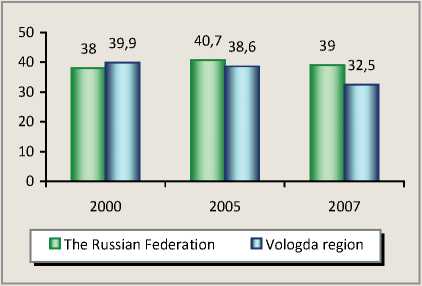
Source: the data of the Vologda regional children's hospital.
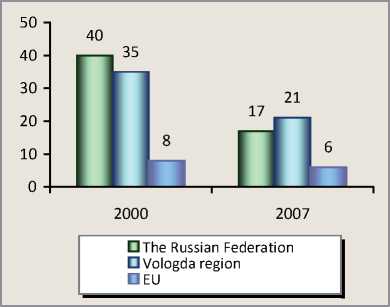
ity of the healthy way of life and the responsibility for the future children’s health.
Despite of the positive tendencies, the Russian Federation (and the Vologda region in particular) continues to remain behind the countries of the European Union under all characteristics of the reproductive health.
Parents reproductive health’s potential, correct reproductive behavior, influencing the opportunity of conception, course of pregnancy and childbirth, mothers’ and children’s health in many respects determine the quality of the population’s reproduction. It determines the necessity and the importance of the reproductive health and demands methodical work on the formation of the correct reproductive behavior, on timely revealing of problems and on their decision.
Список литературы Reproductive health as a factor in quality of population reproduction
- Demographic year-book of Vologda region: coll. of stat./Vologdastat. -Vologda, 2009.
- European database (HFA-DB), WHSO . -Mode of access: http://data.euro.who.int/hfadb/index.php?lang=ru
- Women and men of the Vologda region: Figures and facts: coll. of stat./Vologdastat. -Vologda, 2008.
- The Medical Encyclopedia . -Mode of access: http://www.med74.ru
- The basic parameters of the public health services’ activity in the Vologda region for 2000, 2002, 2006, 2008. -Vologda: Department of the public health services of the Vologda region, 2001, 2003, 2005, 2007, 2009.
- The Regional Strategy of Economic Growth -2015/ed. V.A. Ilyin; VSCC CEMI RAS. -M.: Science, 2007. -244 p.
- Regions of Russia: Social and economic indices, 2008 /Federal service of the state statistics. -Mode of access: www.gks.ru
- Reproductive health: The role of WHSO in the global strategy. Mother’s and children’s health protection and planning family: the quality of help//Materials of the 48th session of WHSO. Series: Technical reports № 569. -Geneva: WHSO, 1977. -P. 7.
- The Russian statistical year-book, 2008 /Federal service of the state statistics. -Mode of access: www.gks.ru
- Family in Russia -2008 /Federal service of the state statistics. -Mode of access: www.gks.ru
- The Strategy in the field of reproductive health /The World health services organization. -Geneva, 2004. -P. 8. -Mode of access: http://whqlibdoc.who.int/hq/2004/WHO_RHR_04.8_rus.pdf

